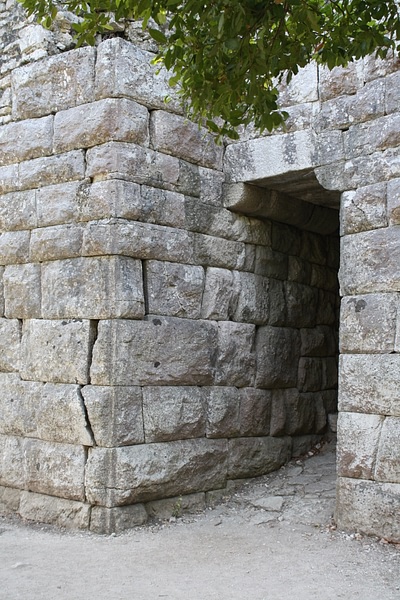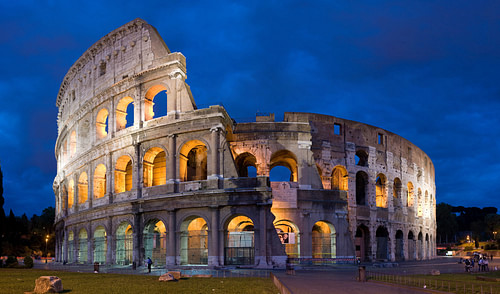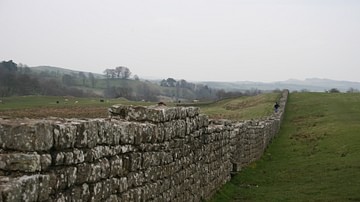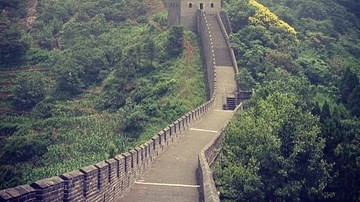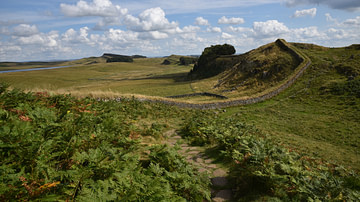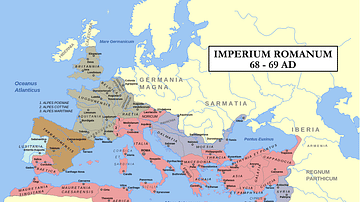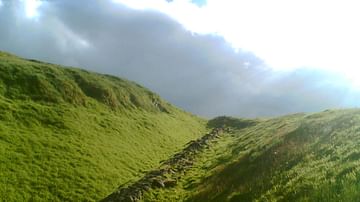The beauty of being an archaeologist is having the good fortune to find something on an archaeological dig that remains in a relatively good state of preservation. In various degrees, there are those who study how nature can actually help the conservation of artifacts and buildings and those who study the natural agents of destruction, such as a particular pH in the soil, a series of floods of a river or other catastrophic events. Volcanic eruptions may well have wiped out entire civilizations, but conversely, the ash and soot produced by them are particularly good at allowing the preservation of ancient artifacts and further, deposits of soot often make it possible to identify the time of a particular eruption, even thousands of miles away from the actual volcano crater.
In contrast, earthquakes have always been a thorn in the side of humanity. The earth is alive; it moves and acts undisturbed and just as no one is able to prevent flooding, so too, no one can predict when the earth will tremble again. Natural events that affect our land are often unpredictable and are certainly inevitable. Despite this, we find it difficult to understand why, in areas of high seismic risk (e.g. California, Italy, and Japan) people still continue to live and build. Progress in construction techniques in some countries has led to counter-measures against the effects of destructive earthquakes. In other countries, however, this has not been the case and even modern buildings remain at risk to significant earthquake damage. We can imagine then, the fate in these places of surviving buildings from medieval and ancient times.
Italy, with its wealth of historic buildings, has been very much at the mercy of these inexorable events over the millennia, which continually change the profile of these lands. The African plate (African Shield) pushes with a movement of subduction against the Eurasian plate (i.e. the African plate slips beneath the Eurasian) and this has been going on for millions of years. The two plates are trying to counteract each other, accumulating a large force that at the moment when the plates can no longer support such pressure, a tremendous force is released creating a shock wave. From time immemorial this mechanism has always been the same: push, energy is stored, a sudden dramatic release of the energy stored and the consequent generation of earthquakes.
For those who have closely studied the geology and topography of ancient Italy the name of Julius Obsequens will not be unfamiliar. He was both a Roman writer and a Roman historian, who described these unusual seismic events, those prodigies in the starry sky, in nature, and particularly earthquakes. Julius described them in chronological order, using the list of Roman consuls (the parts left to us, ranging from 249 BCE to 12 BCE) and he is our primary source for understanding how Italy has been battered by earthquakes over the centuries.
Julius Obsequens wrote in his Book of Prodigies, as of 100 BCE that after an earthquake, incredibly, portions of walls remained standing. Obsequens was surprised at just how the houses remained standing with only their outer walls intact. Throughout the course of history, we have lost somewhere along the road a lengthy series of monuments and sometimes entire cities because of natural disasters. We often think that this destruction is the consequence of the fact that, perhaps once, there was no suitable knowledge, that the constructions were not solid enough, even that there were supernatural phenomena that caused these events, for example, those which led Julius to contemplate how a wall hanging in the balance, skewed, could seemingly be held up by nothing.
However, in Roman times, the documented earthquakes of which we know were the result of a deliberate selection, tending to focus on major cities such as Athens and Rome and in the Republican period of Julius, the rest of Italy under the domain of Rome. Seismic events affecting villages and rural areas were usually overlooked. These prodigious events as Julius handed them to us, then, were always connected to political events and were interpreted as a reaction to the violation of the divine Pax Deorum by humanity. The sins causing these events were expiated with sacrificial rituals and religious ceremonies. An example, reported by Julius, is the earthquake of 91 BCE, which was felt throughout southern Italy. This was linked to a specific event of Roman history: the civil war between the Romans and certain allies requiring Roman citizenship.
In the European context of the ancient world, Italy has always been the great protagonist of natural disasters throughout history, but also across the Mediterranean, volcanic events and earthquakes have caused great destruction (or conservation in a few cases). One thinks of the Minoan eruption (2nd millennium BCE) of Thera, now Santorini, or the eruption of Vesuvius in 79 CE.
Regarding earthquakes, an incredible study has been carried out by the Advanced Laboratory of Historical Seismology of Italian National Institute of Geophysics and Volcanology which has compiled a huge database of earthquake activity ranging from 461 BCE to 1997 CE for the Italian area and from 760 BCE to 1500 CE for the Mediterranean area. Some of the earthquakes are also directly related to volcanic activity, as can be seen by going to Herculaneum with the shock of 25 August 79 CE marked in red. http://storing.ingv.it/cfti4med/#
We have to say that probably what is left of the ancient world is from now on entirely up to us and not nature; the remains we have are definitely more solid than what has been destroyed over time. Nowadays it is difficult to imagine (though not impossible), that an earthquake would take away what little there is left of the ancient world. The materials and construction techniques employed in ancient times were much more solid and consolidated than in the later Middle Ages. We always think back to Herculaneum and Pompeii and see how, despite the great shock, the buildings have structurally held up well, walls are heavier and thicker and better bound together so that even some windows have been preserved. This is in contrast to some medieval towers whose smaller construction elements, less well connected than the Roman structures, have collapsed in a sea of crumbs.
Italy as a modern state, lost the city of L'Aquila with the destruction in 6th of April 2009 CE with an earthquake of magnitude 6.3, and with it came broken lives and distressing moments. It is unlikely that the cultural heritage damaged by this earthquake will ever return to its former glory and the human casualties do place in the background such concerns for historically significant buildings. Only time will heal the wounds. In 2012 CE, once again, Italy was hit by another seismic catastrophe, this time in Emilia Romagna, slightly north of the city of L'Aquila.
In Emilia Romagna, for two months a continuous wave of earthquakes (1600 shocks) continued, shock after shock, to destabilize and torment the whole region. The wave, with peaks of 5.8 and 5.9 on the Richter scale destroyed some of the most important medieval symbols of Italy. The affected area included the entire North of Italy, and earthquakes were felt in Switzerland. For two months everyone, including me, walked with the fear that another shock would take us all away.
However, now that the wave of destruction has settled down, reconstruction of the physical damage has begun. Regarding the tower of Modenesi (Finale Emilia) built in 1200 CE for example, the fallen bricks have been collected and catalogued by volunteers, one by one and with the best remaining pieces they will try to rebuild the tower. The Estense Castle (Finale Emilia), built in 1402 CE, whose towers one by one have slumped to the ground is less fortunate and the reconstruction will perhaps be impossible. Further afield, in the churches of Pisa, Venice, Mantua and Padua, cracks have appeared; particularly significant is the damage to the Basilica of St. Anthony in Padua.
Julius Obsequens in 100 BCE wondered what prodigy kept those walls from crumbling. We are now after almost 2000 years, in the same situation in Italy and we ask why, despite the evidence, the tragedy, the scientific data, still we insist on building in these areas. The earthquakes in Italy may seem little things compared to those of Los Angeles and Tokyo but we Italians are guarding the things which are fragile, those things that time can maintain only if we give a helping hand.
Here below is a list of the damage done to the culturally and historically significant sites within the area affected by earthquakes from May 20 to July 20 2012 CE.
Crevalcore, Bologna
Collapse to the castle of Ronchi. Collapse to the castle of Galeazza. Hall unusable. Considered the historical centre red zone, completely evacuated.
Molinella, Bologna
Various damage to buildings in the centre, damage in the new sports hall and serious damage to nineteenth-century building that housed the square Massarenti IPSIA A.Fioravanti, which has been declared unfit for use after technical measurement.
Brescia, Brescia
Lesions in front of the pawnshop again and in the church of San Clemente.
Verolavecchia, Brescia
Lesions in the bell tower of the parish church of Saints Peter and Paul.
Casalmaggiore, Cremona
Serious damage to the dome of St. Stephen's Cathedral, already damaged by the previous two earthquakes in January 2012, and declared unfit for use.
Cremona, Cremona
Minor damage to some old buildings, evacuated all city schools, some severely damaged.
Scandolara Ravara, Cremona
Serious damage to the church of the Assumption
Bondeno, Ferrara
Several buildings damaged. Various structures collapsed partially or totally, mainly historical and industrial. Serious damage to the churches of the fractions of Scortichino, Burana, Gaven and Pillars: in the latter, in particular, in the historical building Palazzo Mosti was seriously damaged.
Burana (frazione diBondeno), Ferrara
Serious damage to the church and bell tower in the countryside.
Ferrara, Ferrara
Damage to different structures, mainly superficial. More heavy damage to historical buildings and the old town dwellings. Damage to the heritage and history of the city quantifiable in tens of millions of Euros.
Mirabello, Ferrara
Many buildings damaged and partially collapsed. Partially collapsed and severely damaged the church of San Paolo.
Poggio Renatico, Ferrara
Severe damage to the castle Lambertini (collapse of the tower) and the Abbey Church of St. Michael (damage to the bell tower and the dome).
Pilastri (frazione diBondeno), Ferrara
Serious damage to the church and the historical building Palazzo Mosti.
Mantova, Mantova
Fall of the lantern of the dome, partially damaged, the bell tower of the Basilica of Santa Barbara Palatine annexed to the Ducal Palace, some areas of which are damaged. Damage to the Basilica of St. Andrew, the Diocesan Museum, the Palazzo del Podestà, the Palace of Reason and the Palazzo Te.
Poggio Rusco, Mantova
The church was severely damaged mainly due to the earthquake of May 29 that caused the displacement of the tower, severe damage to the town hall and numerous cracks and collapses Falconiera, the tower (symbol of the region).
Roncoferraro, Mantova
Damaged the church of Villa Garibaldi.
Sabbioneta, Mantova
Damaged the parish church of Villa Pasquali, forbidden to use the church of the Carmine in Sabbioneta. Historical monuments slightly damaged. Hermitage of San Remigio evacuated.
San Giacomo delle Segnate, Mantova
Church severely damaged: the collapse of part of the pediment, collapse of the internal vaults. Campanile inclined to risk collapse. Villa Arrigona severely damaged.
Suzzara, Mantova
Damaged the bell tower of the church of the Immaculate Conception with the removal of the dome. Slightly damaged the tower.
Carpi, Modena
Some buildings have received surface damage, the most serious consequences to the artistic heritage with a fall in the local cathedral with injury of the pastor.
Cavezzo, Modena
It is estimated that about 75% of the buildings in the region have been severely damaged.
Mirandola, Modena
Many buildings in the historic centre have suffered serious injury or are partially collapsed. The old town was evacuated and the red zone was set up. Serious damage on the west wall of the Castle of Pico, where the structure is heavily compromised [56]. Damage to the Town Hall, with separation of the north porch of the main building, damage to structures, to the north porch and collapse of the floors. [57] Collapsed vaults of the Church of Jesus. [58] Collapse of the dome (roof and aisles) and the church of San Francesco (the latter has collapsed completely, bell included) [48] [59]. Other historic buildings and public buildings heavily damaged.
Finale Emilia, Modena
La Rocca Estense collapsed in the earthquake of 20 May 2012. The Tower of Modenesi called The Clock Tower collapsed.
San Felice sul Panaro, Modena
Establishment of a red zone in the historic centre, previously evacuated due to widespread collapse. Partial collapses and serious damage to the Estense Castle. Collapsed cathedral, its tower and serious damage to other churches and historical monuments. Clock tower collapsed.
San Possidonio, Modena
Collapses in the bell tower of the church of San Possidonio
Padova, Padova
Minor damage to the Basilica of St. Anthony, the Abbey of Santa Giustina (with a slightly wounded) [66] and other places of worship and historic buildings (some of which have been closed to the public); serious damage to the church of Saint Lucia, whose facade is now unsafe. [67] Maldura building, seriously damaged and unusable, currently being restored to make it accessible to students at the beginning of the new academic year at the University of Padua.
Pisa, Pisa
Damaged “Palazzo della Sapienza”.
Brescello, Reggio Emilia
Slight damage to the church of Santa Maria Rising.
Correggio, Reggio Emilia
Damage widespread throughout the historical heritage. Damaged the Civic Tower and the adjacent Basilica of St. Quirinus, the hall of the Municipal Council, the church of Santa Maria della Misericordia, the church of Santa Chiara and the sanctuary of the Madonna of the Rose.
Guastalla, Reggio Emilia
Structural damage to the Doge's Palace in the city center, declared unfit for use a portion of the historic centre, a few buildings damaged.
Gualtieri, Reggio Emilia
Considerable structural damage to the Bentivoglio palace in the city centre, the Greppi building and the church of Santa Vittoria, both located in the homonymous village..
Reggiolo, Reggio Emilia
Some buildings damaged. Damage to the fortress and agricultural structures. This is common with most of the damage in the province
Ficarolo, Rovigo
Some buildings damaged. The bell tower, already leaning, is tilted even more and is at risk of collapse.
Venezia, Venezia
Fall of a statue that was close to a woman, Papadopoli gardens.
